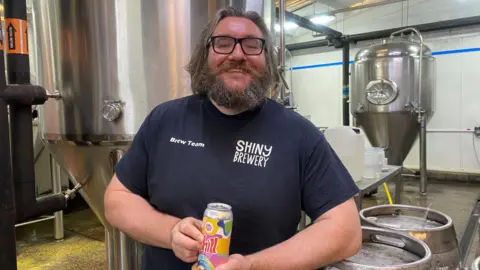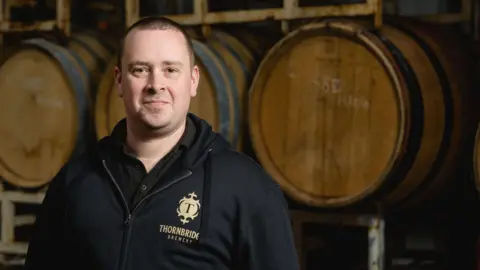Are alcohol-free drinks worth the price in 2025?
 BBC
BBCAt first glance a non-alcoholic beer looks like a normal pint - the same colour, same glass and often has a similar taste.
But the zero and low alcohol beverage sector is one that has "boomed" in popularity across the UK in 2024 and according to global drinks data company IWSR, is a market that could be worth up to £800m in 2028.
For brewers, the process of creating alcohol-free products can be tough and more expensive to make than higher alcoholic products.
So, with another year of growth expected for the no and low alcohol beverages category, are they really worth the price for both producers and consumers in 2025?
Process and costs for breweries
When you hear the term "alcohol-free", you may assume less alcohol means fewer ingredients, and fewer ingredients means less cost.
Ben Wood, a brewer from Thornbridge Brewery in Bakewell, Derbyshire, said the process to craft alcohol-free beers is not so simple.
"It costs more to produce an alcohol-free beer because it involves more processes, more technology, more time and more ingredients," he said.
Some alcohol-free pints are brewed just like regular beers, using the same grains, hops, yeast, and fermentation process, which is the case at Thornbridge.
Dom Driscoll, also a brewer at the Derbyshire firm, said they use less malted barley to get a lower alcohol percentage but use more hops to make the alcohol-free beer taste better.
"We use the same equipment but we use it in a different way," explained Mr Driscoll.
"Over the last few years we have developed our own method to create our low alcohol beer, everybody does it in a different way."
 Thornbridge Brewery
Thornbridge BreweryChris Butcher, manager at Shiny Brewery in Derby, said he uses the same ingredients to create his alcohol-free beers, which also take the same time to make as his regular brews.
"We use water, malted barley, wheat, hops and yeast in a three-week brewing process," said Mr Butcher.
Bigger breweries, such as Heineken, tend to use methods such as vacuum distillation, which requires costly technology, to produce palate-pleasing non-alcoholic beer.
This process reduces the atmospheric pressure, lowering alcohol's boiling point and allowing the beer to be heated to a warm temperature to retain taste while evaporating the alcohol.
But because alcohol is removed, there is still a lower concentration of flavour compounds.
"Rather than cook the alcohol out of the beer with high temperatures or strip it via strict filtration, we use a very specific yeast that doesn't like to make a lot of alcohol - less than you'd find in a ripe banana," added Mr Butcher.
"The skill is in controlling this fermentation process to get a true, close to beer fermented flavour without the alcohol."
The operational costs at Shiny Brewery "remain the same" whether they make a product with or without alcohol.
"The only saving between the two would be the beer duty costs, which range between 30-40p a can," said Mr Butcher.
"However, the additional cost of processing alcohol-free products will take up more than half of this."
A pint of 4.5% Shiny Brewery lager wholesales at £2.10, with 22p profit for the brewer, and costs 4p less with ingredient costs.
A 0.3% alcohol-free pint wholesales at £1.90, yielding a higher profit of 30p with lower tax and zero duty costs.
The British Beer and Pub Association (BBPA) said brewers are making on average two pence per bottle of alcohol-free beer, with pubs making an average of 12p per pint.
"I hope people choose to drink things because they taste good and they have choice as that is a good thing, not because they are simply cheaper without the alcohol", said Mr Butcher.
"I think a good analogy would be decaffeinated coffee. Should it be automatically cheaper despite it having undergone an additional processing step?"
Sales and rising popularity
In 2023, more than 120m pints of no and low alcohol beers were drunk across the UK, with BBPA statistics estimating sales could rise by a further 20m by the end of 2024.
Data released ahead of the 2025 Dry January challenge found 15.5m people planned to not drink for the entire month.
Motivations for this included for participants' health, better sleep and to save money.
This research also points to differences in attitudes and approaches to alcohol between generations.
Alcohol Change UK said around 30% people in the UK who drank alcohol in the last six months report becoming more concerned about the long-term damage drinking may have on them.
These concerns are highest among the 25-34 age group (43%) and lowest among those aged 55 and above (18%).

Steve Kirk, owner of the Neptune pub in Derby, said buying alcohol-free products costs the "exact same price" as higher percentage products.
"The fact we have to sell it at the same price as regular alcohol is not a great incentive for people to chose an alcohol-free alternative," he added.
"If it was cheaper to buy, then we would of course reduce the sale price. I sell about 10 cans a week, so until the price comes down, I won't be buying more stock."
Amit Gill, 24, from Derby, said: "The price would put me off if I'm being honest. If it was cheaper I think it would be more attractive to people."

Clare Wragg, 55 and from Derby, said she loves to drink a 0.0% stout and a 0.0% spiced rum when she is planning to drive when going out with friends.
"I can understand why it is priced the same as regular alcohol drinks because of the process to make it," said Ms Wragg.
"People have to make a profit and yes it would be nice if it was cheaper, but it tastes really good.
"If you get something that tastes good as a normal drink, why not pay the same price?"
Follow BBC Derby on Facebook, on X, or on Instagram. Send your story ideas to [email protected] or via WhatsApp on 0808 100 2210.
